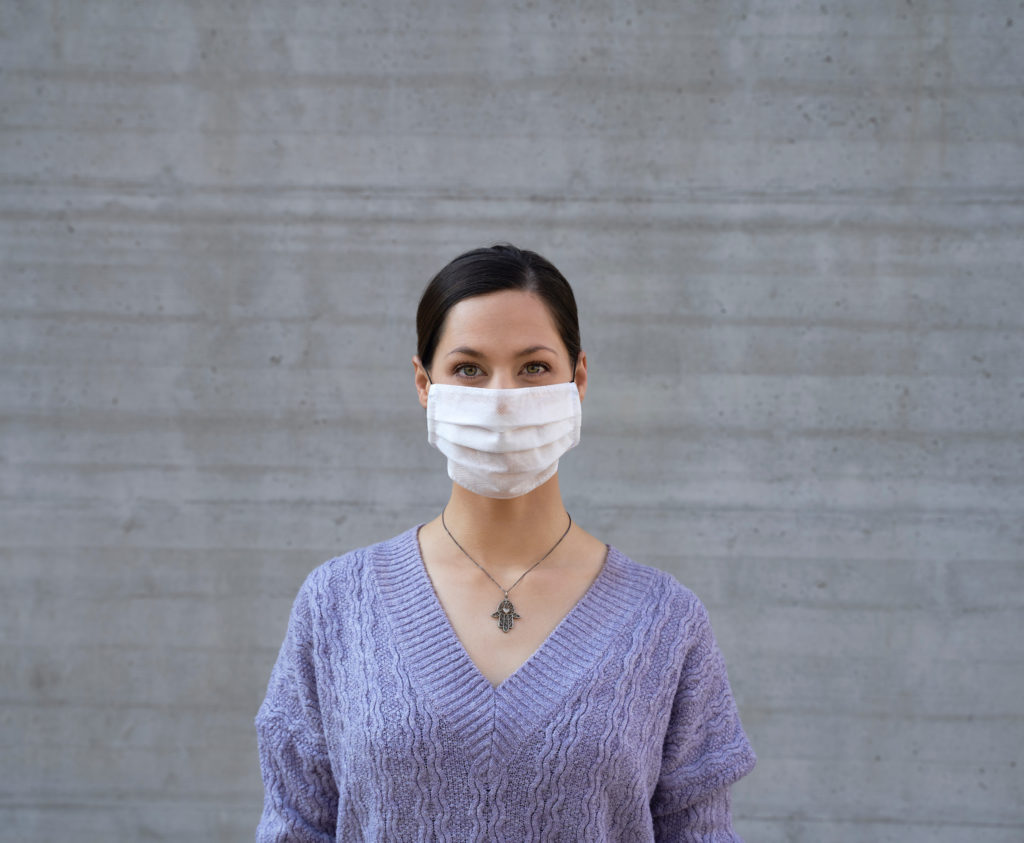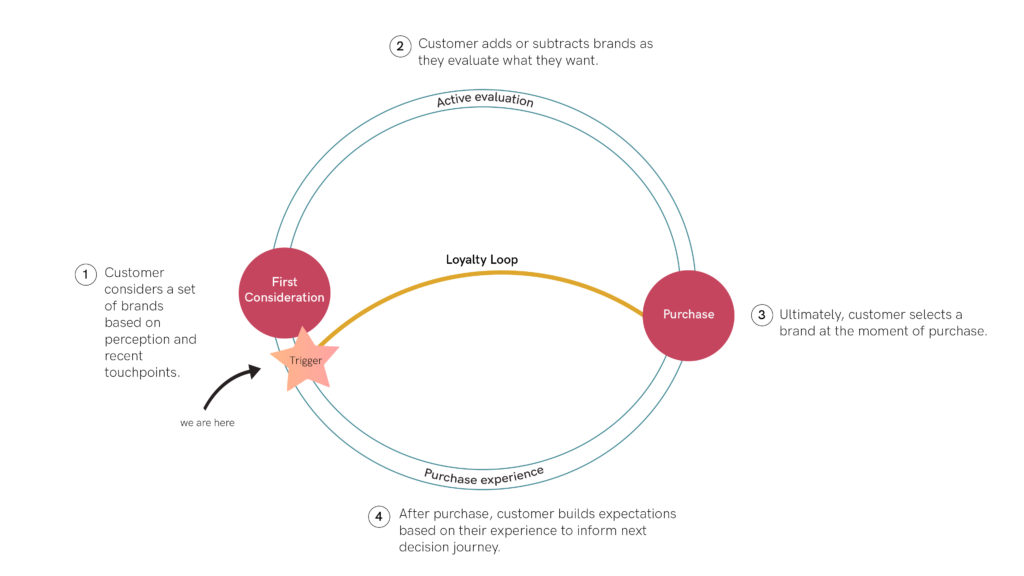
Though we probably don’t need a reminder, it seems that every commercial we encounter these days reinforces the idea that we’re in an unsettling, unprecedented time.
And without diminishing the magnitude and complexity of what we’re experiencing, it’s also true that we now find ourselves faced with an urgent need to connect with others in new ways, to breakthrough and develop innovative ways of interaction and engagement in both our personal and professional lives.
In more than one of our recent virtual roundtables, the conversation about how teams are coming together to address this significant moment has prompted me to think about the opportunities the coronavirus pandemic has opened up. Or at least, the possibility of those opportunities.
As a lot of these roundtable conversations have centered around customer engagement and conversion during COVID-19, I’ve been reminded of McKinsey’s consumer decision journey.
Over a decade ago, McKinsey revamped the widely accepted (and still regularly referenced) purchase funnel metaphor: instead of a funnel representing customers’ theoretical journey through awareness, familiarity, consideration, preference, purchase, and loyalty they introduced a new version, designed to better capture the contemporary marketing environment.
The update was based on global consumer research conducted by McKinsey, which showed that the traditional funnel model failed to capture both the increasingly complex ecosystem of products and touchpoints a person encounters in their purchase experience and the emergence of more discerning, well-informed consumers.
As a result, McKinsey replaced the traditional linear funnel with a new cyclical model: the consumer decision journey (pictured below).

This new framework more accurately captures the way people are constantly evaluating the products and services they use, gathering proof points, and building experience expectations along the way. It also introduces, visually, the idea of a ‘trigger’ moment in which consumers either reinvest in that product or service or go back to the drawing board to actively evaluate their many options.
This idea of a trigger moment fascinates me. It can be as mundane as running low on shampoo or getting into a fender bender. It can also be as extraordinary as a global pandemic.
Regardless of the driver, the mechanism is the same. Triggers represent a critical moment in your relationship with the people you aim to serve. It’s a fork in the road; one path leads back to your company and you want to make that an easy decision.
Ideally, you want to build deep, authentic loyalty with your customers, layer by layer, trigger by trigger, journey by journey around the evaluation cycle. The question is, how can you show up for customers—and those who aren’t yet—in those key moments?
This will come as no surprise to most of you reading this, but… it’s really tough to figure out how to be there for people, in the right way, at the right time. Rarely, if ever, are we privy to know exactly when someone will experience a trigger. In fact, companies spend a lot of time, effort, and money trying to figure this out.
But this is different. There is no guessing here.
The massive opportunity coronavirus has presented us with is a shared experience and understanding between companies and consumers—because we’re all in this together.
Seemingly overnight, we’ve simultaneously experienced a seismic shift in the way we go about our day, do business, learn, teach, shop, play… the list goes on. We know what that Big Trigger was for everyone, and have a sense of what some of the related follow-up quakes are because we’re experiencing them too. In this life-altering moment, triggers abound.
The pandemic is laying bare peoples’ most pressing needs. As individuals, it’s forcing us to consider what’s really important to us and to figure out how we can prioritize those things under the new constraints imposed by COVID-19. For businesses, this is a truly dynamic opportunity to recognize those unmet needs and to figure out how your company can uniquely meet them.

So where does your brand fit in this uncharted landscape?
Are there some parts that are more or less relevant at the moment? What new products or services will be meaningful to people in this new world we find ourselves in? What new channels or means of interaction need to be built? How can you deepen your customer relationships and other partnerships?
This is also a chance to rethink how you’re doing things internally: businesses have had to get creative about how they’re tackling coronavirus-related challenges, and this is opening up new (and in some cases, unlikely and uncomfortable) collaborations between different stakeholders.
At the moment, people are more open to new ways of thinking, and working, and doing business—because priorities are uniquely aligned, and because we have to be. Companies who cannot pivot or innovate at this moment are, at the very least, missing out on possibilities for evolving their businesses; at the extreme end, they may be setting themselves up to be irrelevant in this new environment and in the future.
While I said earlier the mechanism of a trigger is the same, I’ll backtrack on that a little. Because of the severity and seriousness of this coronavirus trigger, the stakes are currently higher. As consumers, we’re all on edge, which makes this a high-risk, high-reward moment for brands.
As a company, you have to tread carefully. That’s why Tom from Brand is joining in on All. Your. Meetings. While that may be grating at times, it also represents one of these new paths you can explore to deepen your relationships with customers and to be there for them in a way that builds loyalty to your brand.
Though it’s hard to synthesize it in real-time, there really is no doubt: this is truly a revolutionary moment. “Pre-COVID” and “Post-COVID” are phrases that have already become a regular part of our language, and the dramatic shift between those two eras will be a defining moment of our lives.
So what will we make of it? Let’s ask ourselves that question in the context of both the personal and the professional.
Will we look back and think of this as a black swan event? It’s hard to see how we won’t. There is no question about the devastation this has caused, especially in certain areas, industries, communities, and families. And whether or not we could have been better prepared, the majority of us were caught off guard—at least by the speed at which our worlds were turned upside down.
Yet even while recognizing that there are a lot of awful things happening, many of which are out of our control, I’m compelled to think about how we can make the most out of the opportunities that are within our sphere of influence. I’m also comforted by the stories about people who are wondering the same thing and putting those thoughts into action.
In his online magazine, Reasons to Be Cheerful, Artist/musician/big thinker David Byrne recently wrote:
“I ask myself, is there something we can learn from this, something that will prepare us to better weather the next crisis, some different way of being that might make us stronger? Is this an opportunity to change our thinking, our behavior? How can we even do that? Are we capable of doing that?”
I truly believe the answer to these questions is a resounding Yes: Yes, it is. Yes, we must. Yes, we can.
So in that way, I think this black swan can also be our blue sky: a significant inflection point that allows us to shake off those things that are weighing us down and allows us to step powerfully into the future.
It’s our chance to think differently about things, with the empathy of shared experiences, including the way we connect with consumers. This brings us back to that original question I posed earlier: how can you show up for your customers and prospects in a way that is meaningful right now? And how might you do so in a way that lays the foundation for long-term engagement?
This will definitely look different for each and every brand, but I have noticed a few patterns from companies that seem to be doing this well.
In this crazy time, it feels even more important than usual to:
- Be human. Remember that there are real people on the other side of that screen, not just users or consumers. And those humans are trying to put together their next Instacart order while “homeschooling” their 7-year old twins and dealing with a spotty internet connection.
- Better yet, be good humans. Reach out. Be compassionate. Be flexible. We’re all going through some sh*t right now and could use a little more understanding in our lives. Meeting people’s emotional needs is of primary concern and they will remember you were there for them when times were tough.
- Show (don’t just tell) who you are as a company. People are hungry for information and primed to be engaged in how companies are handling COVID-19. Start by thinking about your employees and vulnerable groups first—it’s the right thing to do and, per market research firm, Kelton, it’s the thing people care most about.
- Talk to people. Listen, really listen, to what’s on their minds, in their words. Because even though we’re going through this together, remember: You are not the user.
- Be open and creative. Embrace this wild ride as an opportunity to rethink your standard problem-solving approach, or how you typically connect with consumers. You never know what new needs you may discover that could unlock the next phase of your business’s evolution.
The needs are changing every day, but some of the things we’ve been experimenting with are weekly costume contests during our regular huddle meetings, reaching out to our Click Community and greater digital industry in new ways, and rolling up our sleeves to get creative with our clients to help them address their most pressing issues based on the skills sets we have–even if it wasn’t in our original scope of work.
Personally, I’ve found this way of thinking about our work to be a bright spot in a very hazy, stressful, and frustratingly indefinite experience. And while I recognize that this approach will not work for every brand, or team, or individual, I’m hopeful that a lot of us can find our own way to make the most of this moment.
Let’s embrace the high-stakes, high-reward opportunity before us. Let’s lean into the fact that Tom from Brand is butting into every new initiative. Let’s recognize that during this terrible, magical moment, we are all in the same boat, which creates new opportunities to show up for each other and our customers in new, innovative ways.
And finally, remember: this won’t last forever. When we’re on the other side of this acutely difficult moment, what do you want to bring forward with you? I can’t wait to find out.
Categories











